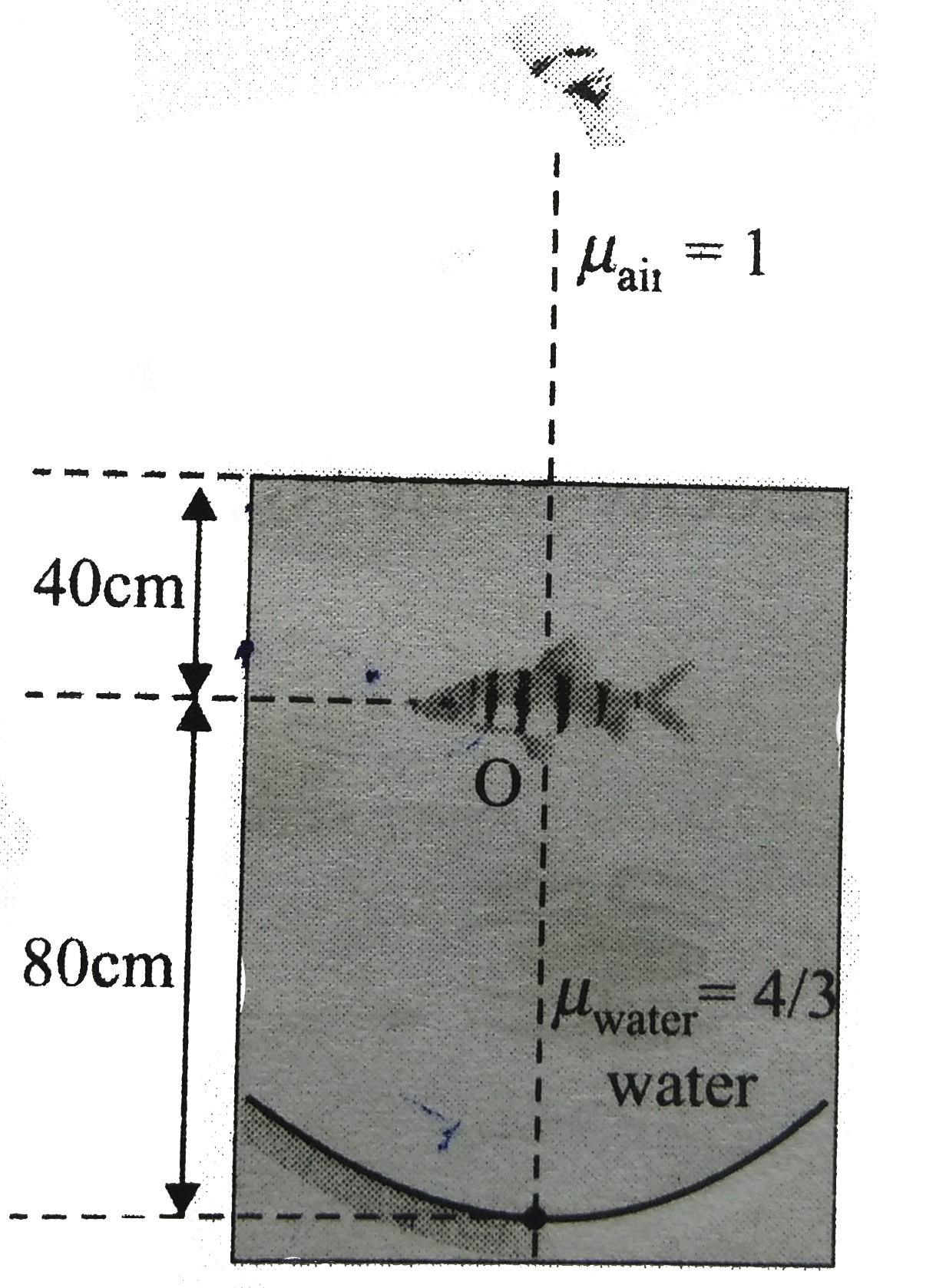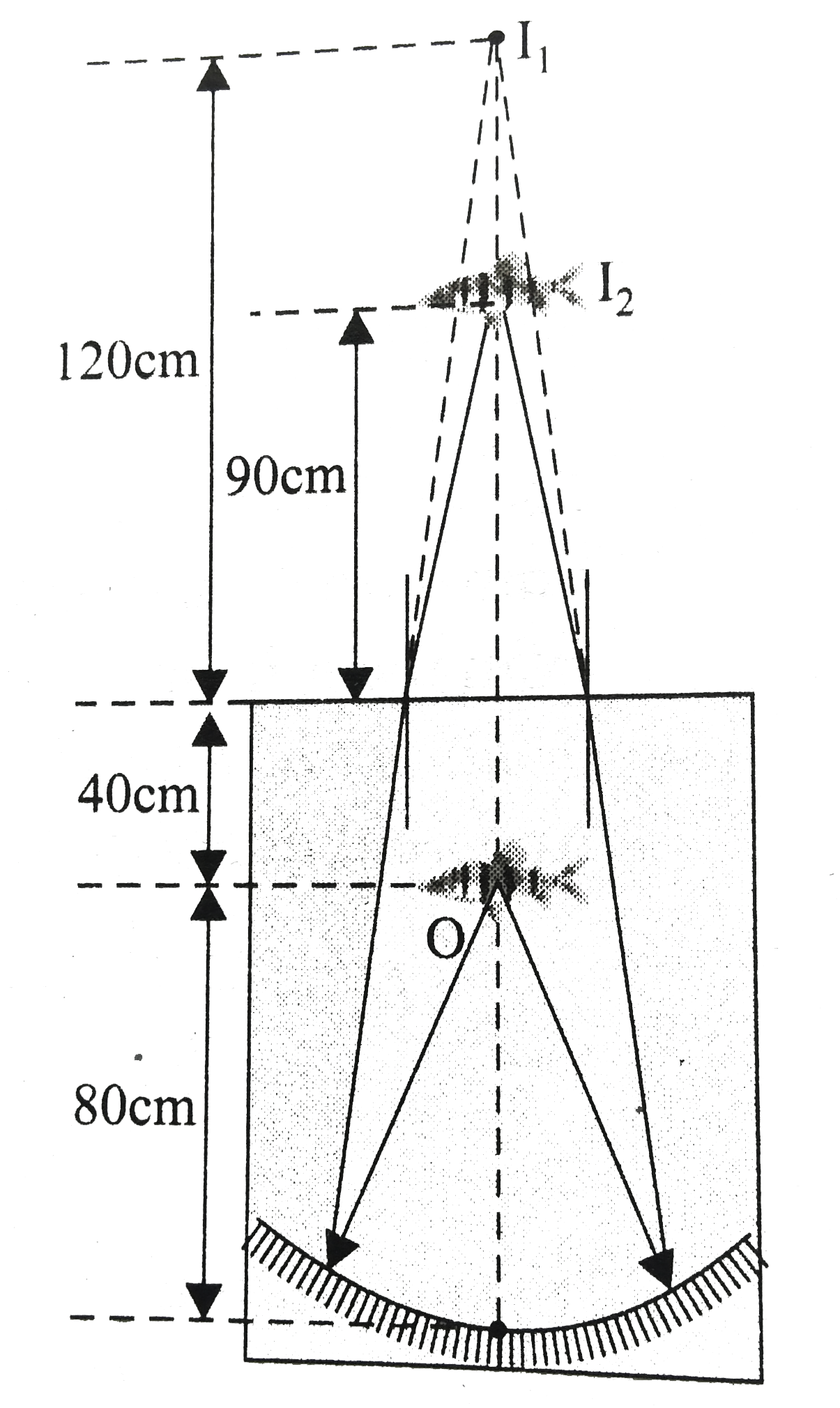Consider the situation skteched. A fish lies 40 cm under the surface of water (μwater=4/3), 80 cm above a concave spherical mirro whose radius of curvature is 120cm. An observer looking down from above in the air (μair=1) sees two images of fish. Find distance (in meters) between these two images.

The observer will observe two images, Once by direct observatino and second will be reflected image forward by mirror.
a. Observer directly observe the fish.
Apparent depth
=Realdepthμrel
=h0(μwaterμair)=4040/3=30cm
The observer will observe fish 30 cm below the water surface when he see directly.
b. Observe obser the reflected image form by mirror.
Considering reflectino from mirror,
u=-80 cm, f=−R2=−1202=−60cm
Using 1v+1u=1f
⇒1v+1(−80)=1(−60)⇒v=−240cm
i.e., 240 cm above mirror or 120 cm above water surface.
Now this image formed by mirror will acts as object for top water surface. Now rays are moving from water to air.
The position of this 'image' as seen by observer observin from top of the water surface
Apparent depth h′=hrealμrel=hrelμwater/μair
=120(4/31)=90cm above water surface
Hence, distance between two images
d=(600+90)=150cm=1.5m

Topper's Solved these Questions
- BOOK - CENGAGE PHYSICSCHAPTER - GEOMETRICAL OPTICSEXERCISE - Solved Examples15videos
GEOMETRICAL OPTICS
- BOOK - CENGAGE PHYSICSCHAPTER - GEOMETRICAL OPTICSEXERCISE - Exercise1.114videos
GEOMETRICAL OPTICS
- BOOK - CENGAGE PHYSICSCHAPTER - FRICTIONEXERCISE - QUESTION BANK1videos
FRICTION
- BOOK - CENGAGE PHYSICSCHAPTER - GRAVITATIONEXERCISE - Question Bank39videos
GRAVITATION
Similar Questions
A concave spherical surface of radius of curvature 100 cm separates two media of refractive indices 1.50 and 43. An object is kept in the first medium at a distance of 30 cm from the surface. Calculate the position of the image.
View SolutionA small point object is placed atOat a distance of0.60metre in air from a convex spherical surface of refractive index1.5.If the radius of the curvature is 25cmthen what is the position of the image on the principal axis.
View Solution
Knowledge Check
- Question 1 - Select One
Water is filled in a container upto a height of 5cm. There is a concave mirror of radius of curvature 40cm. A person just above the surface observes image of 'A'. The distance of image from water surface is (μwater=1.33):
_2019_CBT7_E01_003_Q01.png) A8.8cmB7.8C6.8D5.4
A8.8cmB7.8C6.8D5.4 - Question 2 - Select One
A denser medium of refractive index 1.5 has a concave surface of radius of curvature 12 cm. An object is situated in the denser medium at a distance of 9 cm from the pole. Locate the image due to refraction in air.
AA real image at 8 cmBA virtual image at 8 cmCA real image at 4.8 cmDA virtual image at 4.8 cm - Question 3 - Select One
A point object is placed in air at a distance of 40 cm from a concave refracting surface of refractive index 1.5. If the radius of curvature of the surface is 20 cm, then the position of the image is –
Ain air and at 30 cm from poleBin refracting medium and at 30 cm from poleCin air and at infinityDin refracting medium and at infinity
Light from a point source in air falls on a spherical glass surface (n = 1.5 and radius of curvature = 20 cm). The distance of the light source from the glass surface is 100 cm. At what position the image is formed ?
View SolutionA convex surface of radius of curvature 40 cm separate two media of refractive indices 43 and 1.50. An object is kept in the first medium at a distance of 20 cm from the surface. Calculate the position of the image.
View SolutionA convex spherical refracting surfaces separates two media glass and air (μg=1.5). If the image is to be real, at what minimum distance u should the object be placed in air if R is the radius of curvature
View SolutionIn a medium of refractive index 1.6 and having a convex surface has a point object in it at a distance of 12 cm from the pole. The radius of curvature is 6 cm. Locate the image as seen from air
View SolutionA concave mirror of radius of curvature 40cm forms an image of an object placed on the principal axis at a distance 45 cm in front of it. Now if the system (including object) is completely immersed in water (μ=1.33) , then
View Solution

